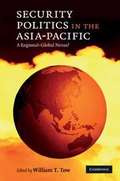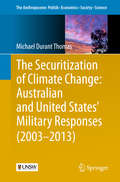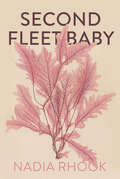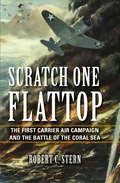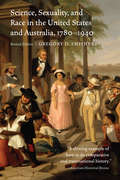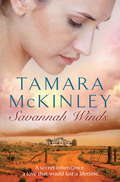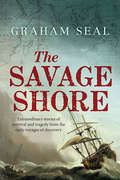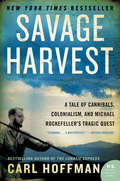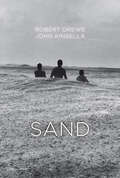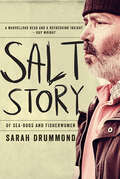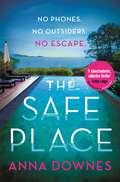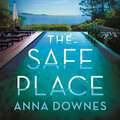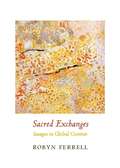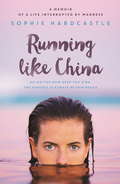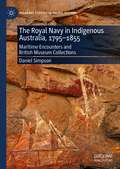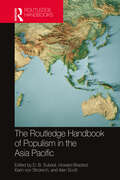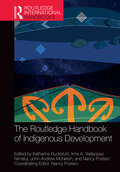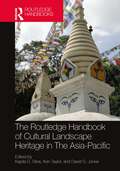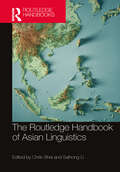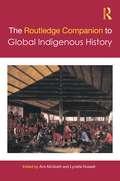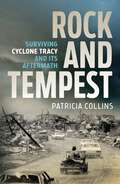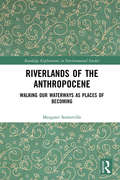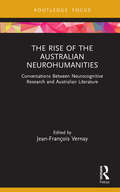- Table View
- List View
Security Politics in the Asia-Pacific: A Regional-Global Nexus?
by William T. TowAsia is experiencing major changes in its security relations. This book brings together respected experts to assess both the theoretical and empirical dimensions of the Asian security debate. Building on the latest research on Asia's regional security politics, it focuses on the 'regional-global nexus' as a way to understand the dynamics of Asian security politics and its intersection with global security. Contributors to the volume offer diverse but complementary perspectives on which issues and factors are most important in explaining how security politics in Asia can be interpreted at both the regional and global levels of analysis. Issues addressed include power balancing and alliances, governance and democracy, maritime and energy security, the relationship between economics and security, 'human security', terrorism, nuclear non-proliferation, climate change and pandemics. This work will serve as a standard reference on the evolution of key issues in Asian security.
The Securitization of Climate Change: Australian and United States' Military Responses (2003 - #2013)
by Michael Durant ThomasThis book examines the process of climate securitization within the United States and Australian political-military sector between 2003 - 2013. Drawing on established securitization frameworks ("Copenhagen" and "Paris" Schools), the author uses a combination of qualitative and quantitative techniques to systematically analyze more than 3,500 official publications from the US and Australian political-military sector. The results offers a rare insight into how each military framed climate change as a security threat and formulated their own unique institutional responses within a heavily politicized context. The book consists of eight chapters divided into four parts; focusing on: perspectives/methodological insights; empirical case studies; case study comparison and concluding observations.
Second Fleet Baby
by Nadia RhookSecond Fleet Baby examines birth and motherhood, drawing on the playful energies and powers of 18th and 19th century ‘convict chicks', including Rhook's own ancestor, who was transported from England to Eora land on the Lady Juliana as part of the notorious 1789 Second Fleet.How might a settler reconcile the violence bound up with their role populating stolen land with the love and euphoria that can flow from parenthood? Intergenerational ties are traced through the soft weapons of the body, connecting the intimacies of nation-making with the politics of reproduction in lavishly personal ways.
Scratch One Flattop: The First Carrier Air Campaign and the Battle of the Coral Sea (Twentieth-century Battles Ser.)
by Robert C. SternA study of the historic World War II naval battle, the first involving aircraft carriers and first in which neither warship was in sight of the other.By the beginning of May 1942, five months after the Pearl Harbor attack, the US Navy was ready to challenge the Japanese moves in the South Pacific. When the Japanese sent troops to New Guinea and the Solomon Islands, the Americans sent the carriers Lexington and Yorktown to counter the move, setting the stage for the Battle of the Coral Sea . . . In this book,historian Robert C. Stern analyzes the Battle of the Coral Sea, the first major fleet engagement where the warships were never in sight of each other. Unlike the Battle of Midway, the Battle of the Coral Sea has received remarkably little study. Stern covers not only the action of the ships and their air groups but also describes the impact of this pivotal engagement. His analysis looks at the short-term impact as well as the long-term implications, including the installation of inert gas fuel-system purging on all American aircraft carriers and the push to integrate sensor systems with fighter direction to better protect against enemy aircraft.The essential text on the first carrier air campaign, Scratch One Flattop is a landmark study on an overlooked battle in the first months of the United States’ engagement in World War II.“His research into sources on both sides is exhaustive and he has used Japanese translators where necessary and appropriate to best illuminate materials. His effort has taken years of meticulous scholarship and it shows. . . . Highly recommended.” —Lisle A. Rose, The Northern Mariner / Le marin du nord
Scratch One Flattop: The First Carrier Air Campaign and the Battle of the Coral Sea (Twentieth-century Battles Ser.)
by Robert C. SternA study of the historic World War II naval battle, the first involving aircraft carriers and first in which neither warship was in sight of the other.By the beginning of May 1942, five months after the Pearl Harbor attack, the US Navy was ready to challenge the Japanese moves in the South Pacific. When the Japanese sent troops to New Guinea and the Solomon Islands, the Americans sent the carriers Lexington and Yorktown to counter the move, setting the stage for the Battle of the Coral Sea . . . In this book,historian Robert C. Stern analyzes the Battle of the Coral Sea, the first major fleet engagement where the warships were never in sight of each other. Unlike the Battle of Midway, the Battle of the Coral Sea has received remarkably little study. Stern covers not only the action of the ships and their air groups but also describes the impact of this pivotal engagement. His analysis looks at the short-term impact as well as the long-term implications, including the installation of inert gas fuel-system purging on all American aircraft carriers and the push to integrate sensor systems with fighter direction to better protect against enemy aircraft.The essential text on the first carrier air campaign, Scratch One Flattop is a landmark study on an overlooked battle in the first months of the United States’ engagement in World War II.“His research into sources on both sides is exhaustive and he has used Japanese translators where necessary and appropriate to best illuminate materials. His effort has taken years of meticulous scholarship and it shows. . . . Highly recommended.” —Lisle A. Rose, The Northern Mariner / Le marin du nord
Science, Sexuality, and Race in the United States and Australia, 1780–1940, Revised Edition
by Gregory D. SmithersScience, Sexuality, and Race in the United States and Australia, 1780–1940, Revised Edition is a sociohistorical tour de force that examines the entwined formation of racial theory and sexual constructs within settler colonialism in the United States and Australia from the Age of Revolution to the Great Depression. Gregory D. Smithers historicizes the dissemination and application of scientific and social-scientific ideas within the process of nation building in two countries with large Indigenous populations and shows how intellectual constructs of race and sexuality were mobilized to subdue Aboriginal peoples. Building on the comparative settler-colonial and imperial histories that appeared after the book’s original publication, this completely revised edition includes two new chapters. In this singular contribution to the study of transnational and comparative settler colonialism, Smithers expands on recent scholarship to illuminate both the subject of the scientific study of race and sexuality and the national and interrelated histories of the United States and Australia.
Saving the Tasmanian Devil: How Science Is Helping the World's Largest Marsupial Carnivore Survive (Scientists in the Field Series)
by Dorothy Hinshaw PatentIn this addition to the critically acclaimed Scientist in the Field series, Dorothy Patent follows the scientists trying to put a stop to a gruesome disease before it’s too late. Tasmanian devils are dying at an alarming rate from a type of tumor that appears to be contagious. What scientists are learning while researching the Tasmanian devil has potential to affect all animals, and even humans, as they learn more about how to prevent and hopefully eradicate certain genetic diseases. In 1995, a deadly disease began sweeping across the Australian island state of Tasmania, killing every infected Tasmanian devil. The disease moved so fast that some scientists feared the species would be wiped out in the wild within a few decades. Where did this disease, named Devil Facial Tumor Disease, come from? What caused it—a virus, bacteria, or something else? How did it pass from one devil to another? What could be done to fight it? When author Dorothy Hinshaw Patent learned of the race to save the devil from her friend, Australian geneticist Jenny Graves, she felt compelled to travel to Australia to learn firsthand from scientists what they were finding out about these iconic Tasmanian animals and what they were doing to help it from disappearing in the wild. Follow Dorothy as she takes readers on a fascinating journey into the Australian mainland and Tasmania, visiting parks and wildlife refuges and joining geneticist, ecologists, and other researchers as they work tirelessly to save Tasmania’s unique icon.
Savannah Winds
by Tamara McKinleyWhen Fleur receives word of a surprise inheritance from an aunt she never knew, it couldn't come at a more opportune moment. Her relationship is crumbling, and she's caught in the middle of a serious family rift. Consulting her aunt's long-lost diary, Fleur sets out on a voyage of historical discovery up the coast and through the Gulf Country, to the isolated cattle ranch Savannah Winds. But unbeknownst to Fleur, what she uncovers there could have devastating repercussions for her own life. Set between the 1930s and the modern day, Savannah Winds is an exploration of family ties, bitter rivalry and the strength of enduring love.
The Savage Shore: Extraordinary Stories of Survival and Tragedy from the Early Voyages of Discovery
by Graham SealFor centuries before the arrival in Australia of Captain Cook and the so-called First Fleet in 1788, intrepid seafaring explorers had been searching, with varied results, for the fabled "Great Southland. " In this enthralling history of early discovery, Graham Seal offers breathtaking tales of shipwrecks, perilous landings, and Aboriginal encounters with the more than three hundred Europeans who washed up on these distant shores long before the land was claimed by Cook for England. The author relates dramatic, previously untold legends of survival gleaned from the centuries of Dutch, Spanish, Portuguese, French, and Indonesian voyages to Australia, and debunks commonly held misconceptions about the earliest European settlements: ships of the Dutch East Indies Company were already active in the region by the early seventeenth century, and the Dutch, rather than the English, were probably the first European settlers on the continent.
Savage Harvest
by Carl HoffmanThe mysterious disappearance of Michael Rockefeller in remote New Guinea in 1961 has kept the world, and even Michael's powerful, influential family, guessing for years. Now, Carl Hoffman uncovers startling new evidence that finally tells the full, astonishing story. On November 21, 1961, Michael C. Rockefeller, the twenty-three-year-old son of New York governor Nelson Rockefeller, vanished off the coast of southwest New Guinea when his catamaran capsized while crossing a turbulent river mouth. He was on an expedition to collect art for the Museum of Primitive Art, which his father had founded in 1957, and his expedition partner--who stayed with the boat and was later rescued--shared Michael's final words as he swam for help: "I think I can make it."Despite exhaustive searches by air, ground, and sea, no trace of Michael was ever found. Soon after his disappearance, rumors surfaced that he'd made it to shore, where he was then killed and eaten by the local Asmat--a native tribe of warriors whose complex culture was built around sacred, reciprocal violence, headhunting, and ritual cannibalism. The Dutch government and the Rockefeller family vehemently denied the story, and Michael's death was officially ruled a drowning. While the cause of death was accepted publicly, doubts lingered and sensational stories circulated, fueling speculation and intrigue for decades. The real story has long waited to be told--until now.Retracing Michael's steps, award-winning journalist Carl Hoffman traveled to the jungles of New Guinea, immersing himself in a world of former headhunters and cannibals, secret spirits and customs, and getting to know generations of Asmat. Through exhaustive archival research, he uncovered hundreds of pages of never-before-seen original documents and located witnesses willing to speak publicly for the first time in fifty years. In Savage Harvest Hoffman finally solves this decades-old mystery and illuminates a culture transformed by years of colonial rule, whose people continue to be shaped by ancient customs and lore. Combining history, art, colonialism, adventure, and ethnography, Savage Harvest is at once a mesmerizing whodunit and a fascinating portrait of the clash between two civilizations that resulted in the death of one of America's richest and most powerful scions.
Sand
by Robert Drewe John KinsellaA collection of prose, poetry, and memoir, this collaboration celebrates the profound effect environment has on our stories, assumptions, and geographical reckonings, just as it evokes childhood nostalgia and a sense of place. In a dialogue of perceptions, two of Australia’s foremost authors explore a common geography and memories—both cultural and personal—as they consider the theme of “sand” from intimate, geological, and historical points of view.
Salt Story: Of Sea-Dogs and Fisherwomen
by Sarah DrummondIn this warm, lively account of living on and by the sea, Sarah Drummond writes of life as an apprentice fisherwoman. Through her firsthand experience with small-scale commercial fishing in the Great Southern, Drummond documents a way of life—fishing—that is slowly dying as waters become politicized and fished out. She writes of fishing, of feuds, and of all the fish that got away. Salt Story is a tribute to sea-dogs, fisherwomen, oystermen, and storytellers everywhere.
The Safe Place: The most addictive summer thriller
by Anna DownesNO PHONESNO OUTSIDERSNO ESCAPE'An exciting and compelling new voice, Anna Downes' The Safe Place is a very accomplished debut' B.A. Paris, Sunday Times bestselling author of The DilemmaRated 4.5 * on NetGalley, this international bestseller is perfect for fans of Liane Moriarty, Lesley Kara and Ruth WareA BEAUTIFUL HOME MIGHT HIDE DANGEROUS SECRETSEmily Proudman has been offered the chance of a lifetime - leave her messy London life, move to a beautiful estate in France and help her boss' wife take care of their daughter, Aurelia. It seems like the perfect opportunity to start again.But once there, Emily soon starts to suspect that her charismatic new employers aren't telling her the whole truth. That there are even dangerous secrets hidden beneath the glamourous facade. Rather than throwing herself headlong into this oasis of wine-soaked days by the pool, Emily can't help but ask questions. Why have the family been moved to this isolated house so far from home? Why does Aurelia refuse to speak or be touched? Why are there whispers in the night? The only problem is, the more Emily knows, the less chance there is she will ever be able to leave . . .PRAISE FOR THE SAFE PLACE'Tense and atmospheric with the seemingly idyllic, yet eerie, setting. A truly gripping read'Karen Hamilton, bestselling author of The Perfect Girlfriend'An outstanding debut. The Safe Place is destined to be a book club favourite'Chris Hammer, award-winning author of Scrublands'It's such a rare thing - a claustrophobic, addictive thriller that lets you actually feel for all of the characters involved'Gytha Lodge, bestselling author of She Lies in Wait'Compellingly disturbing. Anna Downes is a powerful story writer who will lull you into a false sense of security - and then pounce. An author to be watched'Jane Corry, bestselling author of My Husband's Wife 'A brilliantly atmospheric novel that keeps you equally gripped and unsettled from page one. Starkly original and with an alarmingly plausible premise, this is destined to be a bestseller'J.P. Pomare, bestselling author of Call Me Evie'A dark and wonderful debut that lulls you in with beautiful prose and complex, believable characters, then beats you over the head with a killer plot and a thrilling climax. Everyone will be talking about this book!'Christian White, bestselling author of The Nowhere Child
The Safe Place: the perfect addictive summer thriller for 2022 holiday reading
by Anna DownesPerfect for fans of Liane Moriarty, Sally Hepworth and Lesley Kara's The RumourA BEAUTIFUL HOME MIGHT HIDE DANGEROUS SECRETS . . .Emily Proudman has been offered the chance of a lifetime - leave her messy London life, move to a beautiful estate in France and help her boss's wife take care of their daughter. It seems like the perfect opportunity to start again.But once there, Emily soon starts to suspect that her charismatic new employers aren't telling her the whole truth. That there are even dangerous secrets hidden beneath the glamorous facade.Why have the family been moved to this isolated house so far from home? Why does her bosses' daughter refuse to speak or be touched? Why are there whispers in the night? The only problem is, the more Emily knows, the less chance there is she will ever be able to leave . . .(P) 2020 AudioBrien
Sacred Exchanges: Images in Global Context (Columbia Themes in Philosophy, Social Criticism, and the Arts)
by Robyn FerrellAs the international art market globalizes the indigenous image, it changes its identity, status, value, and purpose in local and larger contexts. Focusing on a school of Australian Aboriginal painting that has become popular in the contemporary art world, Robyn Ferrell traces the influence of cultural exchanges on art, the self, and attitudes toward the other.Aboriginal acrylic painting, produced by indigenous women artists of the Australian Desert, bears a superficial resemblance to abstract expressionism and is often read as such by viewers. Yet to see this art only through a Western lens is to miss its unique ontology, logics of sensation, and rich politics and religion. Ferrell explores the culture that produces these paintings and connects its aesthetic to the brutal environmental and economic realities of its people. From here, she travels to urban locales, observing museums and department stores as they traffic interchangeably in art and commodities. Ferrell ties the history of these desert works to global acts of genocide and dispossession. Rethinking the value of the artistic image in the global market and different interpretations of the sacred, she considers photojournalism, ecotourism, and other sacred sites of the western subject, investigating the intersection of modern art and postmodern culture. She ultimately challenges the primacy of the "European gaze" and its fascination with sacred cultures, constructing a more balanced intercultural dialogue that deemphasizes the aesthetic of the real championed by western philosophy.
Running like China: A memoir of a life interrupted by madness
by Sophie HardcastleFrom a talented emerging Australian writer, a brave, honest, unforgettable memoir about mental illness that breaks the silence and shatters the taboos to give hope to all those struggling to find their way through.'When I was eleven years old Mum told me, "One crowded hour of glorious life is worth an age without a name." Even before I heard these words I was always a child who crammed intense joy into tiny pockets of time.'One day Sophie Hardcastle realised the joy she'd always known had disappeared. She was constantly tired, with no energy, no motivation and no sense of enjoyment for surfing, friends, conversations, movies, parties, family - for anything. Her hours became empty. And then, the month before she turned seventeen, that emptiness filled with an intense, unbearable sadness that made her scream and tear at her skin. Misdiagnosed with chronic fatigue, then major depression, then temporal lobe epilepsy, she was finally told - three years, two suicide attempts and five hospital admissions later - that she had Bipolar 1 Disorder.In this honest and beautifully told memoir, Sophie lays bare her story of mental illness - of a teenage girl using drugs, alcohol and sex in an attempt to fix herself; of her family's anguish and her loss of self. It is a brave and hopeful story of adaptation, learning to accept and of ultimately realising that no matter how deep you have sunk, the surface is always within reach. Running Like China shatters the silence and smashes the taboos around mental illness. It is an unforgettable story.
The Royal Navy in Indigenous Australia, 1795–1855: Maritime Encounters and British Museum Collections (Palgrave Studies in Pacific History)
by Daniel SimpsonThis book offers the first in-depth enquiry into the origins of 135 Indigenous Australian objects acquired by the Royal Navy between 1795 and 1855 and held now by the British Museum. In response to increasing calls for the ‘decolonisation’ of museums and the restitution of ethnographic collections, the book seeks to return knowledge of the moments, methods, and motivations whereby Indigenous Australian objects were first collected and sent to Britain. By structuring its discussion in terms of three key ‘stages’ of a typical naval voyage to Australia—departure from British shores, arrival on the continent’s coasts, and eventual return to port—the book offers a nuanced and multifaceted understanding of the pathways followed by these 135 objects into the British Museum. The book offers important new understandings of Indigenous Australian peoples’ reactions to naval visitors, and contains a wealth of original research on the provenance and meaning of some of the world’s oldest extant Indigenous Australian object collections.
The Routledge Handbook of Populism in the Asia Pacific (Indo-Pacific in Context)
by D. B. Subedi Howard Brasted Karin Von Strokirch Alan ScottThis handbook brings national and thematic case studies together to examine a variety of populist politics from local and comparative perspectives in the Asia Pacific. The chapters consider key and cross cutting themes such as populism and nationalism, religion, ethnicity and gender, as well as authoritarianism. They show how populist politics alters the way governments mediate state-society relations. The essays in this volume consider: • diverse approaches in populist politics, for example, post-colonial, strategic vs ideational, growth and redistribution, leadership styles, and in what ways they are similar to, or different from, populist discourses in Europe and the United States; • under what social, political, economic and structural conditions populist politics has emerged in the Asia-Pacific region; • national case studies drawn from South, East and Southeast Asia as well as the Pacific analyzing themes such as media, religion, gender, medical populism, corruption and cronyism, and inclusive vs exclusive forms of populist politics; • modes and techniques of social and political mobilization that populist politicians employ to influence people and their impact on the way democracy is conceived and practiced in the Asia Pacific. As a systematic account of populist ideologies, strategies, leaders and trends in the Asia Pacific, this handbook is essential reading for scholars of area studies, especially in the Asia Pacific, politics and international relations, and political and social theory.
The Routledge Handbook of Indigenous Development (Routledge International Handbooks)
by Katharina Ruckstuhl Irma A. Velásquez Nimatuj John-Andrew McNeish Nancy PosteroThis Handbook inverts the lens on development, asking what Indigenous communities across the globe hope and build for themselves. In contrast to earlier writing on development, this volume focuses on Indigenous peoples as inspiring theorists and potent political actors who resist the ongoing destruction of their livelihoods. To foster their own visions of development, they look from the present back to Indigenous pasts and forward to Indigenous futures. Key questions: How do Indigenous theories of justice, sovereignty, and relations between humans and non-humans inform their understandings of development? How have Indigenous people used Rights of Nature, legal pluralism, and global governance systems to push for their visions? How do Indigenous relations with the Earth inform their struggles against natural resource extraction? How have native peoples negotiated the dangers and benefits of capitalism to foster their own life projects? How do Indigenous peoples in diaspora and in cities around the world contribute to Indigenous futures? How can Indigenous intellectuals, artists, and scientists control their intellectual property and knowledge systems and bring into being meaningful collective life projects? The book is intended for Indigenous and non-Indigenous activists, communities, scholars, and students. It provides a guide to current thinking across the disciplines that converge in the study of development, including geography, anthropology, environmental studies, development studies, political science, and Indigenous studies.
The Routledge Handbook of Cultural Landscape Heritage in The Asia-Pacific (Routledge Handbooks on Museums, Galleries and Heritage)
by Ken Taylor David S. Jones Kapila D. SilvaThe Routledge Handbook of Cultural Landscape Heritage in the Asia-Pacific revisits the use, growth, and potential of the cultural landscape methodology in the conservation and management of culture-nature heritage in the Asia-Pacific region. Taking both a retrospective and prospective view of the management of cultural heritage in the region, this volume argues that the plurality and complexity of heritage in the region cannot be comprehensively understood and effectively managed without a broader conceptual framework like the cultural landscape approach. The book also demonstrates that such an approach facilitates the development of a flexible strategy for heritage conservation. Acknowledging the effects of rapid socio-economic development, globalization, and climate change, contributors examine the pressure these issues place on the sustenance of cultural heritage. Including chapters from more than 20 countries across the Asia-Pacific region, the volume reviews the effectiveness of theoretical and practical potentials afforded by the cultural landscape approach and examines how they have been utilized in the Asia-Pacific context for the last three decades. The Routledge Handbook of Cultural Landscape Heritage in the Asia-Pacific provides a comprehensive analysis of the processes of cultural landscape heritage conservation and management. As a result, it will be of interest to academics, students, and professionals who are based in the fields of cultural heritage management, architecture, urban planning, landscape architecture, and landscape management.
The Routledge Handbook of Asian Linguistics
by Chris Shei Saihong LiThe Routledge Handbook of Asian Linguistics provides a comprehensive overview of the ways in which Asian languages should be conceptualized as a whole, the distinct characteristics of each language group, and the relationships and results of interactions between the languages and language families in Asia. Asia is the largest and the most populous continent on Earth, and the site of many of the first civilizations. This Handbook aims to provide a systematic overview of Asian languages in both theoretical and functional perspectives, optimally combining the two in intercultural settings. In other words, the text will provide a reference for researchers of individual Asian languages or language groups against the background of the entire range of Asian languages. Not only does the Handbook act as a reference to a particular language, it also connects each language to other Asian languages in the perspective of the entire Asian continent. Cultural roles and communicative functions of language are also emphasized as an important domain where the various Asian languages interact and shape each other. With extensive coverage of both theoretical and applied linguistic topics, The Routledge Handbook of Asian Linguistics is an indispensable resource for students and researchers working in this area.
The Routledge Companion to Global Indigenous History (Routledge Companions)
by Ann McGrath Lynette RussellThe Routledge Companion to Global Indigenous History presents exciting new innovations in the dynamic field of Indigenous global history while also outlining ethical, political, and practical research. Indigenous histories are not merely concerned with the past but have resonances for the politics of the present and future, ranging across vast geographical distances and deep time periods. The volume starts with an introduction that explores definitions of Indigenous peoples, followed by six thematic sections which each have a global spread: European uses of history and the positioning of Indigenous people as history’s outsiders; their migrations and mobilities; colonial encounters; removals and diasporas; memory, identities, and narratives; deep histories and pathways towards future Indigenous histories that challenge the nature of the history discipline itself. This book illustrates the important role of Indigenous history and Indigenous knowledges for contemporary concerns, including climate change, spirituality and religious movements, gender negotiations, modernity and mobility, and the meaning of ‘nation’ and the ‘global’. Reflecting the state of the art in Indigenous global history, the contributors suggest exciting new directions in the field, examine its many research challenges and show its resonances for a global politics of the present and future. This book is invaluable reading for students in both undergraduate and postgraduate Indigenous history courses.
Rock and Tempest: Surviving Cyclone Tracy and its Aftermath
by Patricia CollinsWhen Cyclone Tracy flattened Darwin on Christmas Day 1974, it was the worst natural disaster Australians had ever experienced. Stationed in the city with the Women's Royal Australian Naval Service, Patricia Collins not only lived through Tracy but was part of the massive clean-up effort. This is her extraordinary story. The experience of living through a terrifying natural disaster is chillingly told by Collins as she recounts her own dark hours that Christmas, along with those of her contemporaries. They sat huddled in doorways and bathtubs as the winds raged, lifting off roofs, picking up cars and sinking ships. Most of the city was destroyed. Seventy-one people died.The Navy suffered terrible losses. A patrol boat was sunk with the loss of two crewmen and another was driven onto rocks. A sailor lost his wife and two children, and another lost his young son.In the days after Tracy, the majority of Darwin's population was evacuated interstate as the Navy's Task Force arrived to clean up and rebuild. Collins was there as a survivor of Tracy and now an integral part of the recovery.Rock and Tempest contains astonishing first-person accounts of terror and uncertainty as well as courage and survival. It is fascinating and moving, and absolutely essential reading.
Riverlands of the Anthropocene: Walking Our Waterways as Places of Becoming (Routledge Explorations in Environmental Studies)
by Margaret SomervilleThis is an invitation to readers to ponder universal questions about human relations with rivers and water for the precarious times of the Anthropocene. The book asks how humans can learn through sensory embodied encounters with local waterways that shape the architecture of cities and make global connections with environments everywhere. The book considers human becomings with urban waterways to address some of the major conceptual challenges of the Anthropocene, through stories of trauma and healing, environmental activism, and encounters with the living beings that inhabit waterways. Its unique contribution is to bring together Australian Aboriginal knowledges with contemporary western, new materialist, posthuman and Deleuzean philosophies, foregrounding how visual, creative and artistic forms can assist us in thinking beyond the constraints of western thought to enable other modes of being and knowing the world for an unpredictable future. Riverlands of the Anthropocene will be of particular interest to those studying the Anthropocene through the lenses of environmental humanities, environmental education, philosophy, ecofeminism and cultural studies.
The Rise of the Australian Neurohumanities: Conversations Between Neurocognitive Research and Australian Literature (Routledge Focus on Literature)
by Jean-François VernayThis exciting one-of-a-kind volume brings together new contributions by geographically diverse authors who range from early career researchers to well-established scholars in the field. It unprecedentedly showcases a wide variety of the latest research at the intersection of Australian literary studies and cognitive literary studies in a single volume. It takes Australian fiction on the leading edge by paving the way for a new direction in Australian literary criticism.
